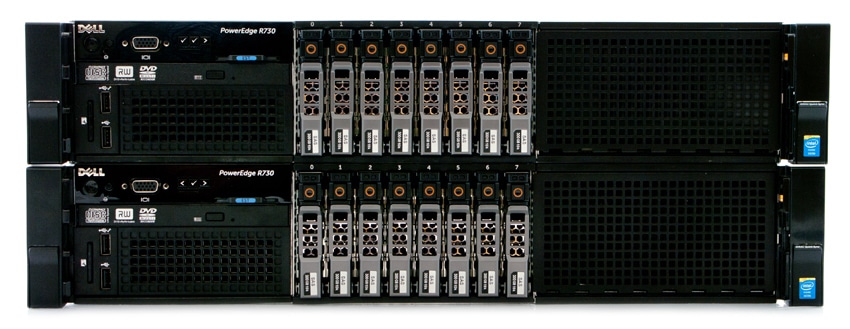 For organizations leading the way with the business-critical solutions, technology refreshes are a fundamental part of doing business. Leading-edge applications can’t wait for legacy infrastructure; be it storage, interconnect, or compute related. The StorageReview Lab faces the same fundamental issues as application workloads become larger and more intense to take advantage of the newest generation of storage and networking products. Last week we took delivery of a dozen Dell PowerEdge 13G R730 servers specifically earmarked to test the latest virtualization and latency-sensitive workloads that face tier zero storage.
For organizations leading the way with the business-critical solutions, technology refreshes are a fundamental part of doing business. Leading-edge applications can’t wait for legacy infrastructure; be it storage, interconnect, or compute related. The StorageReview Lab faces the same fundamental issues as application workloads become larger and more intense to take advantage of the newest generation of storage and networking products. Last week we took delivery of a dozen Dell PowerEdge 13G R730 servers specifically earmarked to test the latest virtualization and latency-sensitive workloads that face tier zero storage.
For organizations leading the way with the business-critical solutions, technology refreshes are a fundamental part of doing business. Leading-edge applications can’t wait for legacy infrastructure; be it storage, interconnect, or compute related. The StorageReview Lab faces the same fundamental issues as application workloads become larger and more intense to take advantage of the newest generation of storage and networking products. Last week we took delivery of a dozen Dell PowerEdge 13G R730 servers specifically earmarked to test the latest virtualization and latency-sensitive workloads that face tier zero storage.

With the goals of pushing our virtualization tests to their limits, we worked closely with Dell on selecting a configuration of Intel Haswell-powered PowerEdge 13G R7300 servers. The main decision to go with a 2U server over a 1U R630 or blade chassis was to accommodate the multiple of HBAs or NICs required for our different testing scenarios. With 7 available PCIe 3.0 slots inside the R730 to not limit the amount of hardware we can install, the choice was easy. For CPU and DRAM we went with a solid midrange configuration of dual Intel Xeon E5-2690 v3 CPUs (2.6GHz, 12 cores, 30MB cache) as well as 256GB of DDR4-2133MHz DRAM.
Dell PowerEdge 13G R730xd Server Specifications:
- Dual Intel E5-2690 v3 CPUs (2.6GHz, 12-cores, 30MB Cache)
- 256GB DDR4 RAM (16GB x 16 DDR3)
- Integrated Perc H730P RAID Card
- iDRAC8 Enterprise
- Quad 1GbE Network Daughter Card
- Mellanox ConnectX-3 VPI NIC
- Emulex Gen 5 Fibre Channel 16GFC or 10GbE Dual-Port Converged Fabric Adapter
With each new generation of enterprise product, be it networking, storage, or compute, the bottleneck is in the infrastructure changes. With our existing server cluster based around Intel Sandy Bridge processors, the refreshes in the storage market, especially with all-flash arrays, have shifted the bottleneck back on our compute cluster. Moving from E5-2690 (8-core 2.9GHz) to the E5-2690 v3 (12-core 2.6GHz) processors we’re able to increase the CPU capacity from 46.4GHz to 62.4GHz per host. With the upgrade path to the E5-2699 v3 (16-core 2.3GHz) processor, we have the potential to increase the CPU capacity to 82.8GHz.
The most important goal of any review site is to build industry buy-in, where enterprise hardware vendors know and trust the benchmarks used to evaluate their gear. By working closely with Dell, StorageReview is able to gain access to valuable resources when adding new benchmarks or gaining insight when researching new technologies. With Dell and other vendors continuing to offer support to the StorageReview Lab, it helps us grow and provide a meaningful resource to customers as they look to research product and making their buying decisions.
